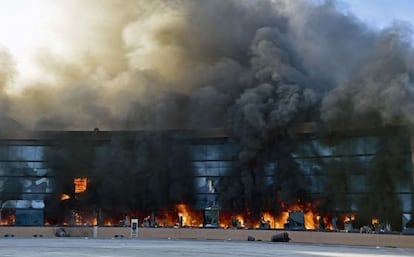Students set fire to Guerrero state headquarters over missing youths
Mexican authorities fear more protests may be on the way after 43 people disappeared


Revenge is knocking on the door. The disappearance and likely murder of 43 college students in Iguala, a town in the southern Mexican state of Guerrero, has unleashed the fury of their classmates.
On Monday evening, enraged youths set fire to the governor’s palace in Chilpancingo after a six-hour siege – a clear affront on the symbol of authority in this increasingly lawless state.
While nobody was hurt in the assault, it only confirmed the escalation of violence that authorities had been fearing ever since 43 student protestors were arrested by local police in Iguala on September 26 and turned over to a local drug gang. Two hitmen later confessed to killing 17 of them, and dozens of as-yet unidentified bodies have turned up in several mass graves outside town.
Despite Governor Ángel Aguirre’s statements to the effect that the bodies were not those of the missing students, the government’s inability to identify the remains quickly or to provide an efficient response to the two-week-old disappearances has turned up the heat on a simmering crisis.
On Monday, around 500 students from the Escuela Normal Rural Raúl Isidro Burgos teachers’ college surrounded the state headquarters and demanded to see the governor. Their request was turned down and the building evacuated, after which demonstrators began hurling rocks and burning parked vehicles. Some then set fire to nearby office buildings, including the one that houses Guerrero’s department of home affairs.
A detachment of around 500 riot police officers was dispatched to the area, but little was done to stop the students, who simply drove off on their buses once they were done.
Authorities now fear that more attacks may be on the way. The college students are part of a highly organized structure that supports left-wing radicalism and has been supplying guerrilla fighters to Mexico’s poor south for decades. Now, the likely death of their classmates at the hands of the Iguala police and the Guerreros Unidos drug cartel has mobilized them like few other things have in recent years.
Their most recent target, the governor’s palace, represents the sum of all evils in their eyes. Governor Aguirre is thought to be dragging his feet with the investigation, if not downright working in connivance with the drug lords.

In any case, Aguirre perfectly illustrates how some Mexican politicians are reluctant to let go of power. A member of the Institutional Revolutionary Party (PRI) for 30 years, he was a senator, a federal deputy and an interim governor. But when his party left him out of the 2011 elections, Aguirre did not hesitate to switch to the leftist Democratic Revolution Party (PRD).
But Guerrero’s descent into lawlessness – it is considered the most violent state in all of Mexico, a place where drug lords are the real wielders of power – has seriously eroded Aguirre’s image. Now, the Iguala crisis has taken his popularity to even lower levels.
Aware that any word or gesture on his part could make matters even worse, Aguirre said nothing about the incidents on Monday, instead letting his aide Jesús Martínez Garnelo do the talking. The latter spoke in conciliatory tones and insisted that the priority right now was finding the missing youths.
But thousands of like-minded students have been streaming into Guerrero from Michoacán, and state authorities have already deployed riot police all over the capital in anticipation of new clashes.
Tu suscripción se está usando en otro dispositivo
¿Quieres añadir otro usuario a tu suscripción?
Si continúas leyendo en este dispositivo, no se podrá leer en el otro.
FlechaTu suscripción se está usando en otro dispositivo y solo puedes acceder a EL PAÍS desde un dispositivo a la vez.
Si quieres compartir tu cuenta, cambia tu suscripción a la modalidad Premium, así podrás añadir otro usuario. Cada uno accederá con su propia cuenta de email, lo que os permitirá personalizar vuestra experiencia en EL PAÍS.
En el caso de no saber quién está usando tu cuenta, te recomendamos cambiar tu contraseña aquí.
Si decides continuar compartiendo tu cuenta, este mensaje se mostrará en tu dispositivo y en el de la otra persona que está usando tu cuenta de forma indefinida, afectando a tu experiencia de lectura. Puedes consultar aquí los términos y condiciones de la suscripción digital.








































